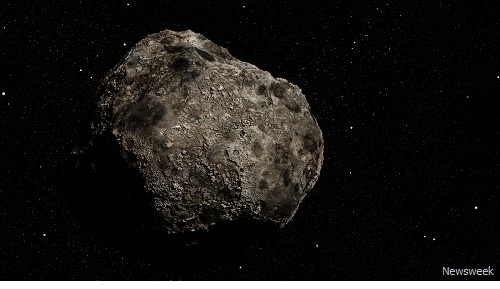
|
|

|
|
| April 20, 2024 |
|
Massive asteroid to pass Earth with second closest approach in at least 120 years 
Next week, a large asteroid which could potentially be as big as the Eiffel Tower is set to whiz past Earth at a speed of more than 28,000 miles per hour.
The space rock, known as 441987 (2010 NY65), is estimated to measure somewhere between 424 and 984 feet (130 to 300 meters) in diameter, according to NASA's Center for Near Earth Object Studies (CNEOS.) Tracking estimates indicate that the object will make its closest approach to Earth on Monday, June 24 at 4:59 p.m. UTC (12:59 p.m. EDT) when it will come within around 1.82 million miles of our planet, or around 7.5 times the distance between the Earth and the Moon. While this may seem like a long way away, in cosmic terms it's in our back yard, although it should be stressed that NY65 has no chance of striking the Earth. As it orbits around the sun, NY65 makes a yearly approach to Earth. In fact, Monday's approach will be the second closest approach since at least 1900, according to projections of its past movements. The only approach which was closer in this period took place last year when the asteroid came within 1.73 million miles of Earth. First discovered in July 2010 by NASA's Wide-Field Infrared Survey Explorer (WISE), NY65 is particularly interesting to astronomers because its recent approaches have taken it very close to Earth, with this trend set to continue for several more years. This makes it a good candidate to study the so-called "Yarkovsky effect, a force acting on a rotating body in space, which requires scientists to take radar measurements over multiple close encounters, NASA says. Such observations can help researchers to understand more about the object and could provide an estimate for its mass. Previous observations conducted in 2015 using the Arecibo radar in Puerto Rico, for example, yielded some basic information about the object's size and spin rate, and also revealed a feature on its surface which could potentially be a crater, according to UCLA's department of Earth, Planetary and Space Sciences. The asteroid is also interesting to scientists because it is classified as a Near Earth Object (NEO), which is considered to be "potentially hazardous." NEO is a term that refers to any asteroid or comet whose orbit takes it within 121 million miles of the Sun, as well as within approximately 30 million miles of Earth. The classification "potentially hazardous" refers to any NEO that has a (typically small) chance of colliding with Earth—i.e., the predicted minimum approach distance is less than 4.6 million miles, and is potentially larger than 460 feet in diameter. If a 460-foot space rock, similar to the lower size estimate for NY65, did strike Earth, it would cause devastation across localized regions in the event of a land impact, or a tsunami that could badly damage low-lying areas if it hit the ocean. According to NASA, such impacts occur roughly once every 10,000 years or so on average. The collision of a 984-foot asteroid, towards the upper end of NY65's size range, would have even wider-reaching effects and could result in global climatic changes which could potentially last for years. Such an impact could produce an explosive force containing 65,000 times more energy than the Hiroshima atomic bomb, according to the Sciency Thoughts blog. Thankfully, impacts such as these are extremely rare. While objects collide with our planet all the time, the vast majority are small (a diameter of less than 30 feet) and burn up in the atmosphere, so we don't even notice them. Currently, researchers know of more than 19,000 NEOs, of which around 2,000 are considered potentially hazardous, with about 30 new discoveries added each week, according to NASA. While there are a handful of potentially hazardous objects that are predicted to have a small chance of colliding with Earth in tens to hundreds of years, the odds will likely fall as monitoring stations make further observations, enabling more accurate predictions of their trajectories. Nevertheless, NASA estimates that two-thirds of NEOs larger than 460 feet remain to be discovered so there are still likely many potentially hazardous objects which are unaccounted for. (Source: Newsweek) Story Date: June 19, 2019
|